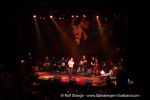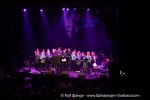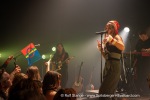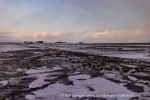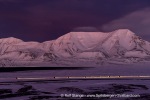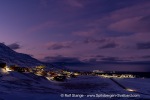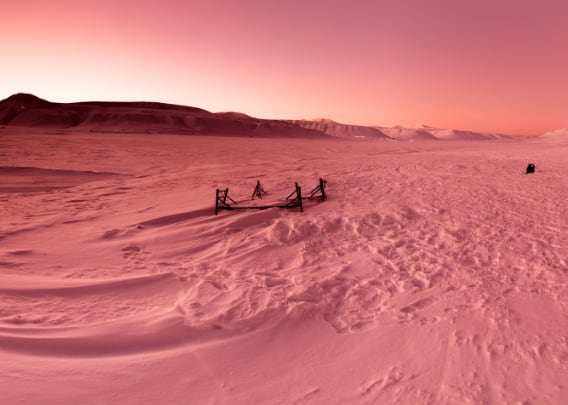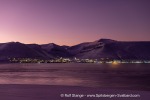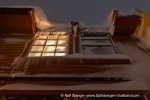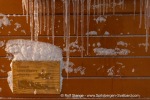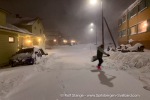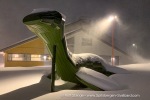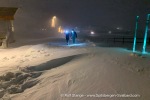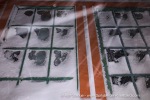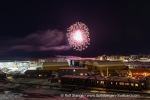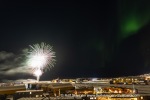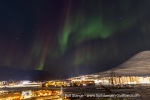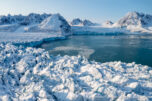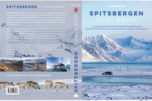-
current
recommendations- Liefdefjord
New page dedicated to one of Spitsbergen's most beautiful fjords. Background information and many photos.
- New Spitsbergen guidebook
The new edition of my Spitsbergen guidebook is out and available now!
- Liefdefjord
New page dedicated to one of Spitsbergen's most beautiful fjords. Background information and many photos.
Page Structure
-
Spitsbergen-News
- Select Month
- May 2025
- April 2025
- March 2025
- February 2025
- January 2025
- December 2024
- November 2024
- October 2024
- September 2024
- August 2024
- July 2024
- June 2024
- May 2024
- April 2024
- March 2024
- February 2024
- January 2024
- December 2023
- November 2023
- October 2023
- September 2023
- August 2023
- July 2023
- June 2023
- May 2023
- April 2023
- March 2023
- February 2023
- January 2023
- December 2022
- November 2022
- October 2022
- September 2022
- August 2022
- July 2022
- June 2022
- May 2022
- April 2022
- March 2022
- February 2022
- January 2022
- December 2021
- November 2021
- October 2021
- September 2021
- August 2021
- July 2021
- June 2021
- May 2021
- April 2021
- March 2021
- February 2021
- January 2021
- December 2020
- November 2020
- October 2020
- September 2020
- August 2020
- July 2020
- June 2020
- May 2020
- April 2020
- March 2020
- February 2020
- January 2020
- December 2019
- November 2019
- October 2019
- September 2019
- August 2019
- July 2019
- June 2019
- May 2019
- April 2019
- March 2019
- February 2019
- January 2019
- December 2018
- November 2018
- October 2018
- September 2018
- August 2018
- July 2018
- June 2018
- May 2018
- April 2018
- March 2018
- February 2018
- January 2018
- December 2017
- November 2017
- October 2017
- September 2017
- August 2017
- July 2017
- June 2017
- May 2017
- April 2017
- March 2017
- February 2017
- January 2017
- December 2016
- November 2016
- October 2016
- September 2016
- August 2016
- July 2016
- June 2016
- May 2016
- April 2016
- March 2016
- February 2016
- January 2016
- December 2015
- November 2015
- October 2015
- September 2015
- August 2015
- July 2015
- June 2015
- May 2015
- April 2015
- March 2015
- February 2015
- January 2015
- December 2014
- November 2014
- October 2014
- September 2014
- August 2014
- July 2014
- June 2014
- May 2014
- April 2014
- March 2014
- February 2014
- January 2014
- December 2013
- November 2013
- October 2013
- September 2013
- August 2013
- July 2013
- June 2013
- May 2013
- April 2013
- March 2013
- February 2013
- January 2013
- December 2012
- November 2012
- October 2012
- September 2012
- August 2012
- July 2012
- June 2012
- May 2012
- April 2012
- March 2012
- February 2012
- January 2012
- December 2011
- November 2011
- October 2011
- September 2011
- August 2011
- May 2011
- April 2011
- March 2011
- February 2011
- January 2011
- December 2010
- November 2010
- September 2010
- August 2010
- July 2010
- June 2010
- May 2010
- April 2010
- March 2010
- February 2010
- November 2009
- October 2009
- August 2009
- July 2009
- June 2009
- May 2009
- April 2009
- March 2009
- February 2009
- January 2009
- December 2008
- November 2008
- October 2008
- August 2008
- July 2008
- June 2008
- May 2008
- April 2008
- March 2008
- February 2008
- April 2000
- Select Month
-
weather information
-
Newsletter

| Guidebook: Spitsbergen-Svalbard |
Home →
Yearly Archives: 2025 − News & Stories
Longyearbyen’s drinking water: legionella and manganese
For decades, most consumers in Longyearbyen have probably not given much thought to their drinking water. After all, it is drinking water from the surrounding arctic nature, so surely it should be clean? Even after intermediate storage in the artificial lake Isdammen in Adventdalen or – depending on the season – in a drinking water reservoir on the outskirts of Gruvedalen. Of course, there is also filtering and monitoring.
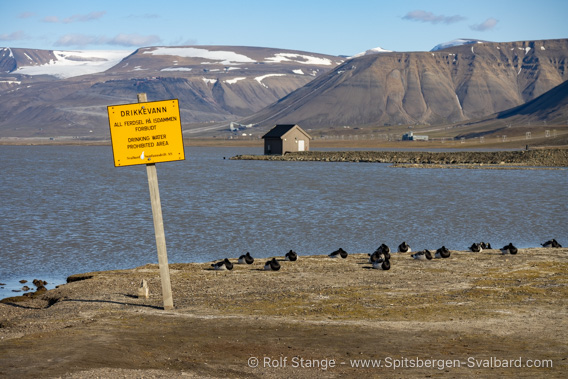
The drinking water lake ‘Isdammen’ in Adventdalen.
But the carefree tranquillity around drinking water has been over for a few months now: Legionella bacteria have been detected in drinking water samples from Longyearbyen. This is initially no reason to panic, as tap water that is completely free of legionella is rather rare worldwide. It depends on the exact type of germ and its number. Many Legionella types are harmless to humans, and bacterial counts below the permitted limits are almost always present, especially in older pipe networks such as in Longyearbyen.
However, due to the rather dribbling communication strategy of the local authority (Longyearbyen Lokalstyre), the issue did become, well, an issue. It was a bit like ‘we have legionella in our drinking water, but don’t worry, everything is fine’. More precise details on the type and bacterial count were not made public; according to official information, the water was (and is, with one caveat, see below) still drinkable and safe for human health.
At the end of February, Lokalstyre organised a residents’ meeting to provide information on the current situation regarding drinking water (legionella and manganese, see below), and there are now a number of announcements and press releases on the Lokalstyre website as well as articles and letters to the editor in the Svalbardposten.
No health problems due to Legionella are said to have occurred so far. These could occur primarily by inhaling germ-contaminated very small water droplets (aerosole) in the air, for example when showering. A potential risk is said to exist above all for risk groups such as older or immunocompromised people.
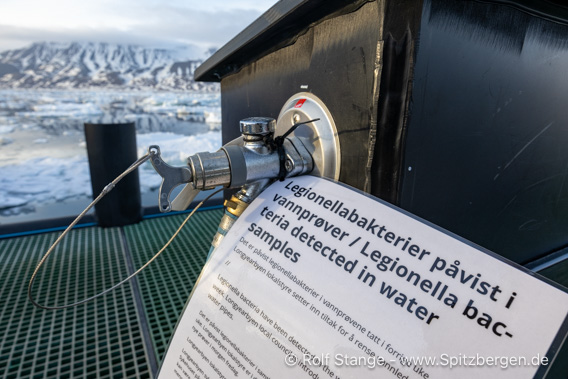
Legionella notice at the drinking water tap in Longyearbyen harbour.
A source for the germ could not be localised; it is likely that large parts of the old pipe network and the biofilms contained therein are the diffuse source. The levels (bacterial counts) were temporarily reduced by adding chlorine and the pipes were flushed several times in sections, but neither is a definitive solution, at least not in the sense that Legionella will disappear in the long term. At times, consumers were advised to take precautionary measures, such as showering without a shower head to avoid atomising the water into fine droplets that could be inhaled. Svalbardhallen (swimming and sports hall) was also closed at times. All in all, there was quite a lot of fuss about a problem that was actually harmless according to official information, which led to a certain amount of concern in town.
It will probably come down to the fact that chlorine will have to be added to the drinking water again and again in the long term in order to keep the bacterial load within acceptable limits. The side effect is that the drinking water tastes of chlorine, just like in a swimming pool. It looks like you have to get used to it. There are also small, household water filters based on activated carbon that help the water regain its fresh flavour. Others have been buying bottled water from the Svalbardbutikken supermarket for some time. The large (five litre) bottles are now rationed there: only three bottles are sold per household per day so that there is enough for everyone.
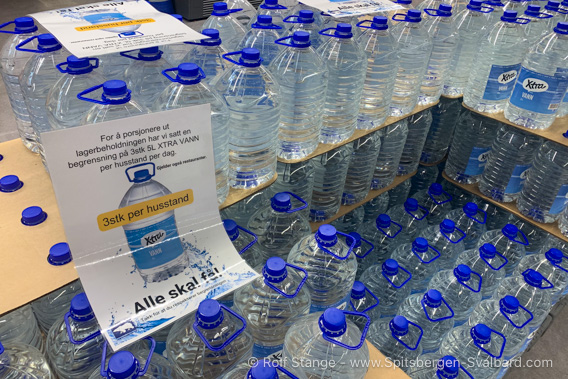
Water bottles in Svalbardbutikken.
But there is another problem: manganese, a metal (chemically more precise: transition metal) that occurs frequently in nature, including in the sedimentary rocks around Longyearbyen. Manganese is also present in pretty much every sip of drinking water worldwide, but as always, the quantity is the point.
The Norwegian Health Authority (FHI, Folkehelseinstitutt), which was consulted, has now concluded that the manganese levels in the drinking water have been too high since September 2024 to supply infants (0-12 months) with it. Affected families can get free bottled water at Svalbardbutikken. For everyone else, however, there should be no health risk associated with the consumption of tap water; health-relevant exposure should only occur at higher concentrations over longer periods of time (10 years and more). Acute poisoning is only theoretically possible at extremely high concentrations.
This is the official position. For adults (everybody older than 12 months 😄), the following therefore still applies: raise your glasses and cheers, it just sometimes doesn’t taste quite fresh, but it doesn’t matter.
I would like to expressly point out that I am not an expert on drinking water and Legionella and manganese in it; I am summarising official reports to the best of my knowledge, but not my own assessment or opinion.
The Arctic Chamber Music Festival
One of the major annual events in Longyearbyen’s cultural calendar is the “Arctic Chamber Music Festival”, which this year is dedicated to the art of storytelling as well as music.
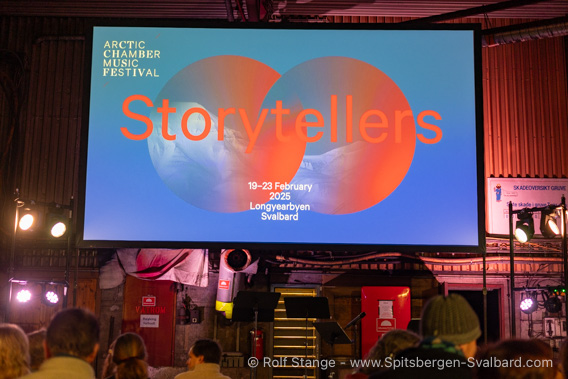
This year’s motto of the ‘Arctic Chamber Music Festival’: Storytellers.
As with the Dark Seasons Blues Festival and Polar Jazz, there is plenty on offer for the audience. For example, at noon on Saturday at the Svalbard Museum, the story of Willem Barentsz’ expedition, who famously discovered Spitsbergen in 1596, was told in music …
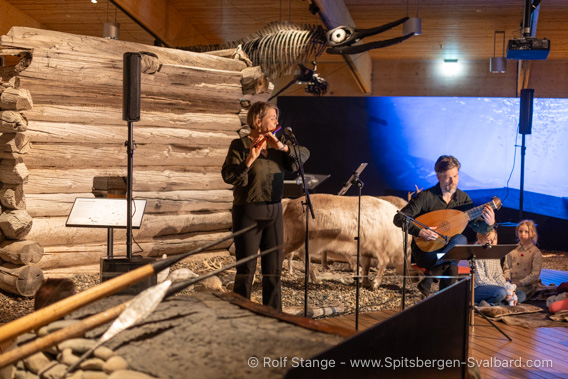
Torun Torbo with the ‘Barentsz flute’ and Solmund Nystabakk on the lute
at the Svalbard Museum.
… with contemporary music played on a flute that is an exact copy of the flute found in the remains of Barentsz’ winter camp on Novaya Zemlya, accompanied by a lute. The original flute can be seen in the Rijksmuseum in Amsterdam.

Torun Torbo with the ‘Barentsz flute’:
‘Tonen i isen’, the Barentsz story told musically.
Probably the highlight of this year’s chamber music festival in Longyearbyen was the Saturday evening concert. Not only because the highlights are presented at this prime time, but also because the venue had to be moved at short notice for technical reasons – to the day facilities of Mine 7! The venue itself thus became an event of exclusive value, as this last Norwegian coal mine still in operation is not normally open to the public.
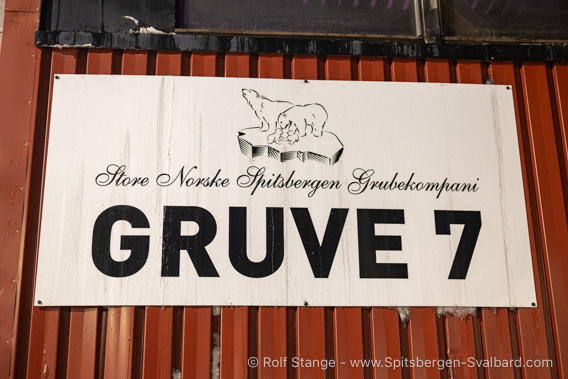
Mine 7: suddenly the venue for the Arctic Chamber Music Festival.
In prose and music, there was the story of one of the loneliest theatre and ballet stages in the world, in California’s Death Valley:
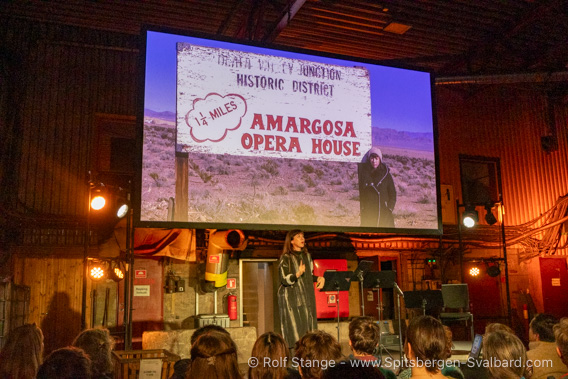
Missy Marzoli from New York introduces Marta Becket and her (Marta’s) lonely theatre
in Death Valley Junction …
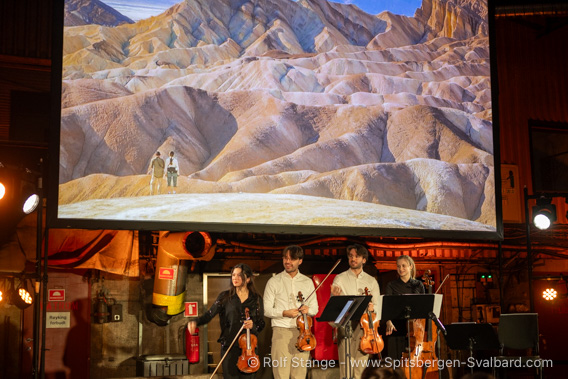
… musically realised by the NOVO Quartet from Denmark.
This was followed by the life and work of the Venetian composer Barbara Strozzi, impressively performed with soprano and lute.
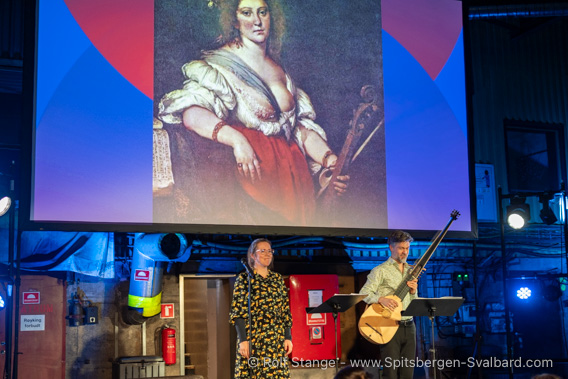
Berit Norbakken (soprano) and Solmund Nystabakk (lute).
The somewhat unhappy looking lady above is Barbara Strozzi (approximately 1619-1677)
And of course that wasn’t all that was on offer at the Arctic Chamber Music Festival. There was so much more, from ‘Peter und der Wolf’ to the ‘Four Seasons’.
Tilia-Ensemble in Longyearbyen and Tromsø
If you are spontaneous or happen to be in the area anyway, you can enjoy another musical highlight next week, when the Tilia Ensemble from Dresden performs a programme of music from the far north in the Svalbard Church on Tuesday (25 February) and the famous Tromsdalen Cathedral in Tromsø on Friday.
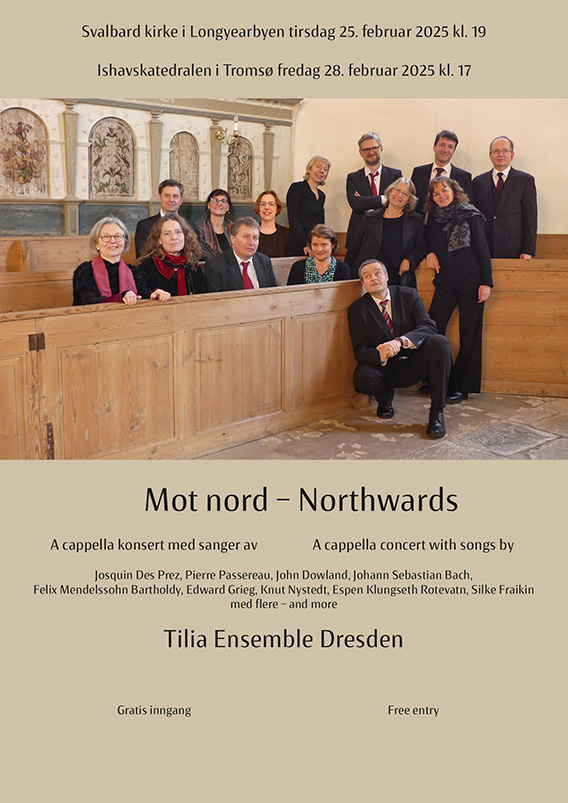
Tilia Ensemble: 25th Feb in Longyearbyen, 28th Feb in Tromsø.
New pages
Things are progressing here too. One of the most beautiful places on Spitsbergen finally got the page it deserves, namely Kapp Linné. Be sure to check it out! And the page about Gjertsenodden in St. Jonsfjord is not new, but it has been improved. Others too, but that’s enough for now.
And what else?
As I write this (on Sunday, 23rd February), a few kilometres away, on the north side of Adventfjord, a polar bear is walking around, and Sysselmester’s helicopter is already in the air to chase it away from town. It is the first polar bear to come close to Longyearbyen this year, as far as I have heard.
Light and darkness
Let there be light! Today, 16 February, the people in and around Longyearbyen were able to enjoy the first sunrise since 25 October, at least in theory. In between was the polar night, which has now come to an end.
Shortly after noon, however, the sun barely managed to reach 0.16 degrees above the horizon, hiding behind the mountains of Longyearbyen. It will only return to Longyearbyen on 8 March.
But on the heights around Longyearbyen it was possible to catch a few rays at midday today, like here on the slope of Hiorthfjellet on the north side of the Adventfjord.
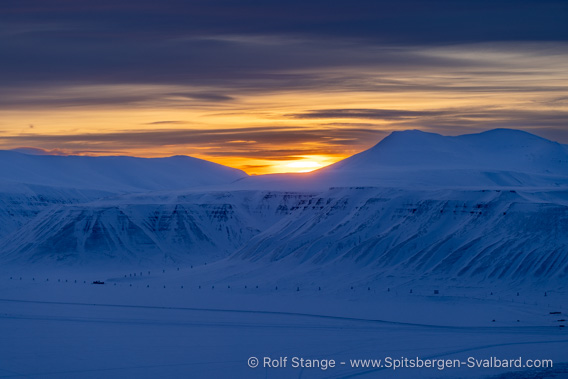
The first sunrise of the year on 16 February at midday over Adventdalen.
A few clouds made sure you didn’t get an overdose of sunshine.
And if that was too much, you can always take refuge in the glacier cave at Longyearbreen.
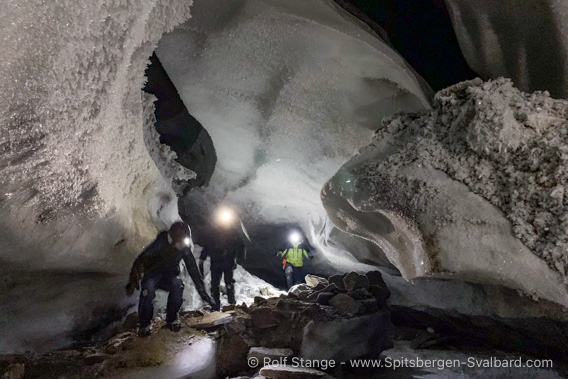
Glacier cave in Longyearbreen.
There it is really – REALLY! – dark without a lamp.

Glacier cave in Longyearbreen without lamp 😄.
Polarjazz
The days when the polar night meant only darkness and scurvy are long gone. Today Longyearbyen offers a lot of variety even in the dark winter. The cultural calendar always offers a lecture (often in Norwegian) or other smaller events.
Sometimes there are larger events, such as the Polarjazz jazz festival last weekend. Just as the Dark Seasons Blues Festival at the end of October, Polarjazz features local artists as well as well-known Norwegian and international musicians. Both festivals have been an integral part of Svalbard’s cultural calendar for many years.
Longyearbyen’s music scene kicks off
Polarjazz was opened on Thursday evening in Kulturhuset (the cultural centre) by a number of local artists. It is impressive how many active musicians Longyearbyen has to offer – after all, it is a village with a population of around 2500. But how many villages with a population of 2500 can put together a programme of almost three hours, with hardly anyone on stage for more than one song?
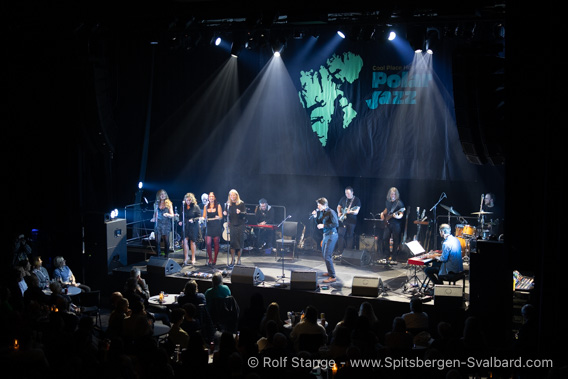
Opening evening of the Polarjazz festival
with musicians from Longyearbyen at the Kulturhus.
Commissioned work for the Spitsbergen Treaty
The programme continued until Sunday, with numerous events. One of the highlights was undoubtedly the world premiere of a work by Bugge Wesseltoft in the Huset, commissioned and realised for the 100th anniversary of the Spitsbergen Treaty, which came into force in 1925. In the nine sequences of his work, Wesseltoft has incorporated everything he associates with Svalbard, both sonically and visually, to the delight of audiences and critics alike.
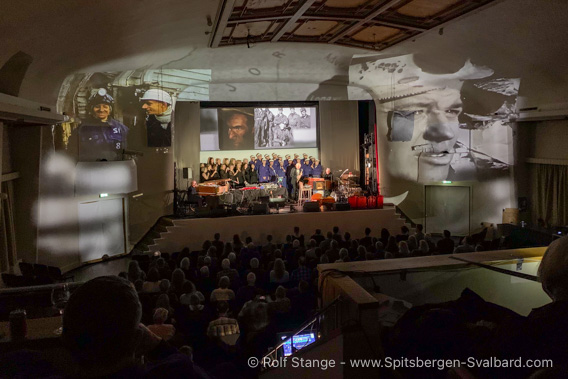
World premiere of the work by Bugge Wesseltoft at Huset.
Few, if any, seem to have noticed that he chose the Wellman-Bjørvig-Bentsen story, a drama from 1898-99 set in the Russian archipelago Franz Josefs Land, for the section devoted to the dramatic history of the various north pole expeditions, or they have simply overlooked it.
Ella Marie Hætta Isaksen
Another highlight was the performance of Sami singer and actress Ella Marie in Kulturhuset. Here the music was hot and loud, with modern sounds that didn’t lose their cultural roots. The political messages were not neglected either, such as the politically committed Sami singer’s unmistakable greeting to the Norwegian government, in which two middle fingers played the leading roles. Anyone who has the chance to see Ella Marie Hætta Isaksen, as she is known in full, on stage should not miss it.
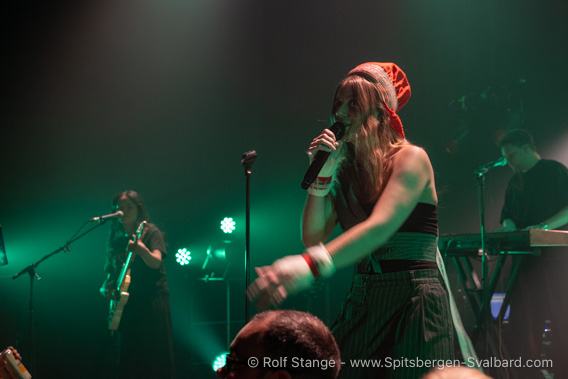
Ella Marie and band on stage in kulturhuset.
If you are thinking about taking a cultural trip to the polar night, you can take a look at the programme on their own website (2026 is still a long way off, although preparations are already underway behind the scenes).
And what else? The light is coming back, the dark core of the polar night is giving way to daylight. But it will be a few weeks before the sun really comes back again.
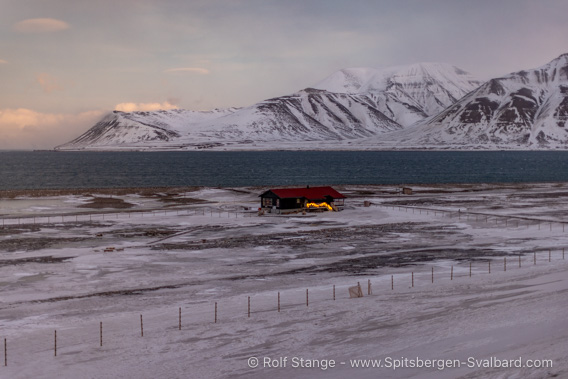
View over the campsite on Tuesday at noontime: the polar night is coming to an end.
As usual, a few more pictures for further impressions:
- gallery anchor link: #gallery_3498
Click on thumbnail to open an enlarged version of the specific photo.
The iron bed in the red-light district
The title might make your thoughts go astray 🤪 but don’t worry, this post doesn’t need an age limit.
I recently mentioned ‘Jernsenga’, ‘the iron bed’ in Adventdalen. If you want to know what that is all about and what the story behind it is, you can take a look at a new page I have created since then. Just click here and you’ll be in Adventdalen in your mind’s eye.
And as a visual highlight, there is a panoramic view on that page, taken in this incredibly beautiful red light that we recently had. It really looks like what I imagine it would look like on Mars, it was quite incredible!
So as not to spoil anything, there’s no picture here now. But you will of course find pictures on the new Jernsenga page.
And if you want even more of the beautiful red light, you should take a look at Innerhytta.
The polar night
… is over. At least if you define the end of the polar night as the day on which ‘civil twilight’ returns at noon, i.e. the sun is 6 degrees or more below the horizon. This was the case yesterday (30 January) at just after 12 noon for the first time since 11 November.
Twilight: civil, nautical, astronomical
When the sun is lower than -6 degrees around the clock (i.e. 6 degrees below the horizon), this is called polar night. Before and after this, there are several weeks when the sun does not rise, but is very low below the horizon at midday (between 0 and 6 degrees), so that there is a clear twilight. This is known as ‘civil twilight’, which people experience as dawn. There is also nautical twilight (the sun is 6-12 degrees below the horizon, which can still be seen by navigators at sea) and astronomical twilight (the sun is 12-18 degrees below the horizon, which can still be seen by astronomers with a trained eye), and only when the sun is lower than 18 degrees below the horizon do we officially speak of darkness.
In Longyearbyen, it does never happen that the sun is lower than 18 degrees below the horizon for 24 hours. Even at the darkest time, around 21 December, the sun is still between 11 and 12 degrees below the horizon at midday, so that when the sky is clear there is a hint of twilight to the south. Strictly speaking, it is never completely dark for 24 hours in Longyearbyen.

The end of the polar night: view of Hiorthfjellet on 30 January, spiced up with a dose of red light (Rayleigh-scattering).
You can read more about this on the corresponding page midnight sun and polar night.
Pictures: the end of the polar night
A few impressions from yesterday (30 January) at noon, although I had already missed the brightest point. There was indeed a good whiff of that wonderful red light in the air again, although it wasn’t as intense as it was a week ago.
- gallery anchor link: #gallery_3492
Click on thumbnail to open an enlarged version of the specific photo.
Red light
I need to come back to the stunning phenomenon of the red light again. Firstly, in last week’s post (‘Red sky’) I somehow forgot to mention the name of the phenomenon that is ultimately responsible for this red light. It is called Rayleigh scattering. That should be added.
And I also captured the red light in a complete 360 degree panorama last week, it just had to be processed first. Here is an example from Adventdalen, at ‘Jernsenga’ (‘the iron bed’, there is indeed a bedstead standing in the landscape. But that is another story, for another day). There is another red light pano on the Innerhytta page, taken on a pingo a little further into Adventdalen.
- pano anchor link: #250123b_Jernsenga_55
Ships as an economic factor in Longyearbyen
In Longyearbyen, as in many other places, not everyone is happy to see cruise ships in the harbour. The cruise industry, especially with its larger ships, is not always welcomed in Longyearbyen.
And the locals have certainly been annoyed by the queues at the post office, the supermarket or the overcrowded café, and drivers regularly react with incomprehension to tourists who mistake the road between the harbour and the town centre for a footpath. It’s all there for all to see on the days in question.
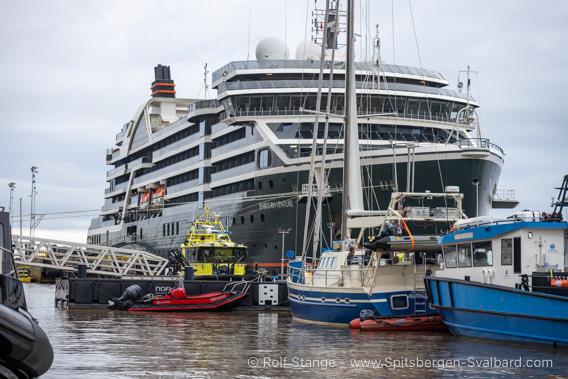
Ships of all sizes come to Longyearbyen. They all leave money there.
What is invisible, however, is what the ships bring to Longyearbyen: economic power in the form of a lot of money. Of course, those who don’t get a seat in the café or slalom down the street at walking pace are not necessarily the ones whose bank accounts fill up. But the amounts are considerable, and a significant part of it is distributed widely through the wages of numerous service providers and sales in shops.
Now we have some figures for 2024:
- The somewhat smaller ships (‘expedition ships’) left 235 million kroner (around 20 million euros) in Longyearbyen.
- The corresponding figure for the larger cruise ships is 112.5 million kroner (around 9.6 million euros).
- Passengers on smaller ships are also ahead when it comes to personal spending: on average, expedition ship passengers spent 8090 kroner (around 690 euros) per person, while cruise ship passengers spent 1886 kroner (160 euros).
- Ny-Ålesund benefited from 21,000 visitors who came as tourists on ships with 14 million kroner (approx. 1.2 million euros).
These figures are considerable, especially as these are very small towns: In purely mathematical terms, ship tourists leave behind around 12,000 euros for each of Longyearbyen’s 2500 inhabitants. This includes fees for the harbour, which the municipality owns but cannot freely dispose of for legal reasons, but also hotels, retailers, restaurants and local tour operators.
It would be interesting to know exactly what these sums are spent on and where the money goes. However, this is not clear from the information available. It comes from a report by the Danish consultancy Epinion for the industry association Visit Svalbard. They found the figures so high that they asked Epinion to check for errors before they took it further. However, the report turned out to be correct and some of the key figures have now been published in Svalbardposten.
Red sky
Thursday (23 January) was one of those rare purple days. It really is rare. When this light comes, it seems to happen preferably during the polar night, as it is coming near the end, as was the case on 10 January 2018, when there was an article about it in Svalbardposten.
It probably happens less than once a year that the sky turns red in such a magnificent way. Yesterday was one of those days when you can count yourself lucky if you’re in the right place. And even more so if you’re able to spontaneously drop the hammer and head out into Adventdalen with your camera, away from the artificial light.
A few impressions:
- gallery anchor link: #gallery_3489
Click on thumbnail to open an enlarged version of the specific photo.
The colour of the photos really corresponds to the impression you got on the spot.
The physics of the red sky
In the Svalbardposten article linked above, Dag A. Lorentzen, then as now professor of geophysics at UNIS, explains the phenomenon by the refraction of sunlight in high atmospheric layers, at an altitude of about 20 kilometres. However, the meteorological conditions must be just right: These include a very cold atmosphere in these layers of air and the formation of special clouds that refract the light in exactly the way that produces this colouring. These ‘clouds’ themselves are not visible; they are weak concentrations of ice crystals rather than what is commonly thought of as clouds. In this case, the parts of the spectrum from violet to green are mostly lost due to refraction and scattering, leaving the remaining wavelengths (mainly red) to dominate.
The actual circumstances must be so exact that the phenomenon of the ‘red sky’ is so rare. In my opinion, the colour impression is more violet, but as the violet part of the spectrum of visible sunlight is the first to be lost, the term red is probably more appropriate from a physical point of view.
Purple haze
The appropriate soundtrack is of course ‘Purple Haze’ by Jimi Hendrix 🙂.
Fresh vegetables …
… are currently a bit difficult in Longyearbyen. This has happened before, after all, it is still at the end of the world or at least not far off. But things are getting thinner now and will probably stay that way for a while. This is what some of the shelves in the fresh produce section of the Svalbardbutikken supermarket look like these days:

Empty shelves in Svalbardbutikken.
The regular cargo plane stopped operating at the end of last year. A replacement is planned, but not yet in sight.
Cargo ships come regularly to Longyearbyen, the passage from Tromsø takes 3-4 days. However, the logistics are obviously not yet perfect, and depending on the weather, it is not unheard of that a cargo of eggs arrives in the shape of of scrambled eggs mixed with cardboard and eggshells.
At the moment, Svalbardbutikken has no choice but to ask its customers to be patient.
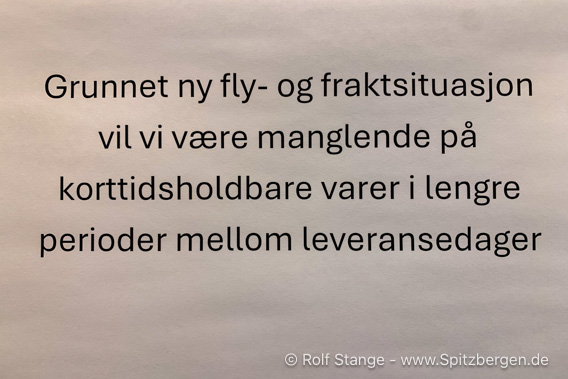
Notice on an empty shelf: ‘Due to the new flight and freight situation, there will be a shortage of perishable goods between deliveries for some time.
Until the airport opened in 1975, Longyearbyen was cut off from supplies for months in winter. After the war and until 1975, there was a mail plane that occasionally made deliveries by ‘mail drop’ (literally). There were probably no bananas or eggs in it either, and the contents of many a tin of apricots had to be scraped out of the snow later, frozen 🙂. At that time there was a ‘jernku’, an ‘iron cow’, in which milk was made from powdered milk. The term ‘jernku’ is often used in Longyearbyen these days, with a slightly sarcastic undertone. There was indeed a real cow, and sometimes several ones, but the milk it produced was reserved for pregnant women and families with small children.

Cows in Longyearbyen (1937). Photo: Odd Danielsen.
For now, we have to make do with what we have. The cargo ship is due to arrive on Monday.
New pages
By the way, if you have the time and inclination to let your mind wander a little more towards Spitsbergen, you can do so on the new pages that are being created during the long evenings of the polar night. After years of exploring remote corners of the island also regarding new pages within this website, I’m now concentrating more on the beautiful places we’ll be visiting in the future. There are still many unknown corners to be discovered, but I’m going to take a more or less systematic approach, starting with a few well-known spots. Trygghamna with Alkhornet and Ymerbukta together with the neighbouring beautiful Erdmannflya will certainly be remembered fondly by some.
I mentioned Sassenfjord and Tempelfjord in this context back in December. The gap between them will also be closed in the future.
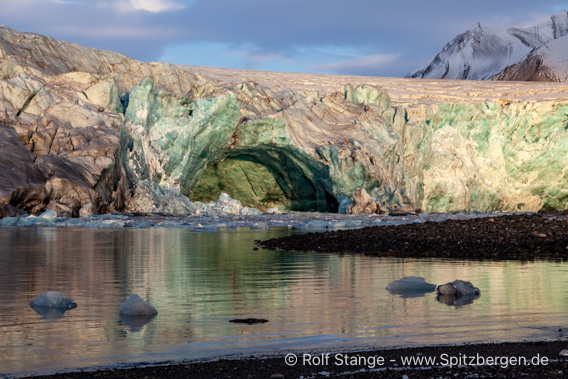
Esmarkbreen in Ymerbukta: still one of my favourite glacier photos,
in beautiful light at the end of September. One of many photos on the new Trygghamna, Alkhornet and Ymerbukta & Erdmannflya pages.
Have a nice weekend!
Snow
It can happen that quickly. It looked like this the other day:

Northern lights over Longyearbyen.
And today like this. It can happen that quickly.
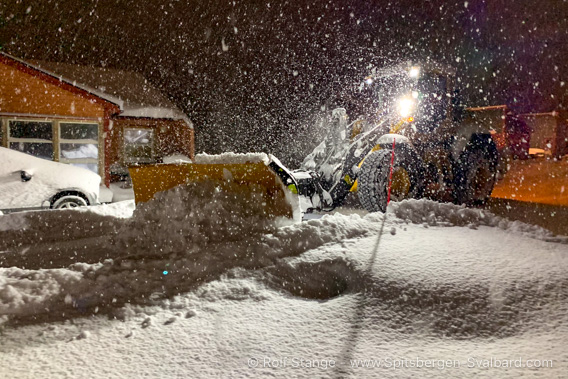
Snowstorm in Longyearbyen.
Wind and lots of snow, that’s a combination that brings some excitement. These amounts of snow are unusual for Longyearbyen, where the overall climate is still arctic and thus rather low in precipitation, and bring challenges with them: air traffic is impaired and individual buildings and sections of terrain have already been evacuated or closed by the Sysselmester due to the risk of avalanches. So far, this affects little used buildings and snowmobile trails near slopes in Longyearbyen, but on a day like this it’s better to leave the horses in the stable anyway.
The slopes at Sukkertoppen near the central residential areas have been equipped with extensive avalanche barriers since the deadly avalanche in 2015, otherwise the residential areas in this area might also have already been affected by evacuations.
- gallery anchor link: #gallery_3480
Click on thumbnail to open an enlarged version of the specific photo.
New rules: the details
There may be more attractive things to talk about than going into the small print of a comprehensive new set of rules, but the much-discussed new rules will from now on determine where we can and cannot go in Svalbard, and much more besides. So they are important. And above all, it is clear that there is a lot of uncertainty and a need for clarification. There are now rumours and misinformation circulating, which I would like to counter.
So there’s only one thing to do: you have to get into the details to see what it is all about. This is not only important for guides who need to know the facts, but also if you are wondering whether a trip to Spitsbergen will still be worthwhile in the future (the short answer: yes).
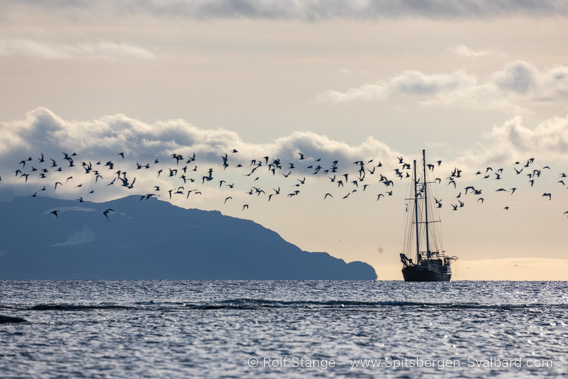
Spitsbergen under sail: still possible, still beautiful. In future, especially in key regions where we will continue to have freedom of movement as usual.
However, I won’t be doing this as part of a post that will be pushed down more and more by newer posts over time, but on a separate page within the ‘Spitsbergen information’ section, which will remain where it is. Click here to open this new page.
Rumours and nonsense
The following is not true:
- ‘You are only allowed to go ashore in 43 places on boat trips in Svalbare.’ That’s rubbish, we still have plenty of space for landings and hikes. Refer to the new page for further details.
- ‘Many bird colonies are now closed and may no longer be visited.’ That’s rubbish, but there are speed limits in many places. Details … You can guess where they are.
- ‘You can no longer see polar bears in Spitsbergen.’ Yes, you can, but distances apply (500 metres until the end of June, 300 metres from the beginning of July). Close-ups are no longer possible in Svalbard, but with binoculars and a good telephoto lens, you can still have a great experience and take some great photos. And this law does not apply at the drift ice outside the twelve-mile zone.
- ‘You are no longer allowed to visit walrus colonies.’ Yes, you can. The minimum distances that are now prescribed for walruses apply to boats. As soon as you are on land, you can visit walrus colonies as usual.
- ‘Svalbard is no longer an interesting travel destination.’ This is wrong, Svalbard is and remains a beautiful, interesting destination with many possibilities. We still have plenty of space for shore excursions and hikes and we will still be able to see lots of wildlife, including walruses, polar bears (the latter at the distances mentioned above) and bird colonies.
New pages: Midterhukhamna and more
During the polar night and in the relative calm of the beginning of the new year, you can relax and create beautiful new pages, also to take your mind off the sometimes somewhat routine work on the updated editions of the Svalbard guidebook. This reference to these beautiful new pages is intended as an easily digestible introduction to the Svalbard news section 2025.
Panorama landscape Bellsund
Bellsund has so far been somewhat sparsely represented in the Svalbard panorama section, which of course does not do justice to this varied and beautiful area, and there is certainly more than enough material for corresponding pages in the archive, they just have to be created bit by bit. Midterhukhamna and Gåsberget (Midterhuken) are a nice step forward with two brandnew pages. Enjoy the virtual trip there, the view over Bellsund is fantastic and the whole area really is a natural gem.
- Midterhukhamna: coastal landscape in Bellsund.
- Gåsberget at Midterhuken: panoramic view over Bellsund.
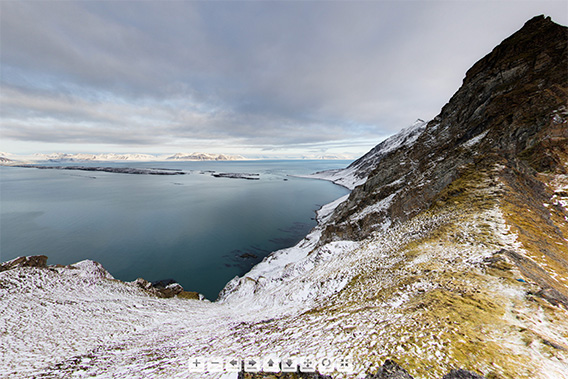
View from Midterhuken in Bellsund: a mouse click worthwhile. The picture here is just a screenshot, the real panoramas can be rotated 360 degrees on the screen.
If you fancy more of Bellsund, you should for example visit Observatoriefjellet and Snatcherpynten in Recherchefjord, or Akseløya including Russeltvedtodden. There is plenty of good stuff.
Happy New Year! New Year’s Eve in Longyearbyen
The fireworks in Longyearbyen are certainly not the most spectacular in the world. There are hardly any private fireworks, but there are two public fireworks displays on New Year’s Eve: one family-friendly at 7 pm, the second classic at midnight.
While the fireworks themselves may not be the biggest on the planet – for which some people and certainly all animals are grateful – there was a very quiet, beautiful firework display from above as an encore 😀 and that was certainly quite unique.
Happy new year!
Fireworks in Longyearbyen
From earth and the sky.
- gallery anchor link: #gallery_3468
Click on thumbnail to open an enlarged version of the specific photo.
News-Listing live generated at 2025/May/04 at 07:42:58 Uhr (GMT+1)
